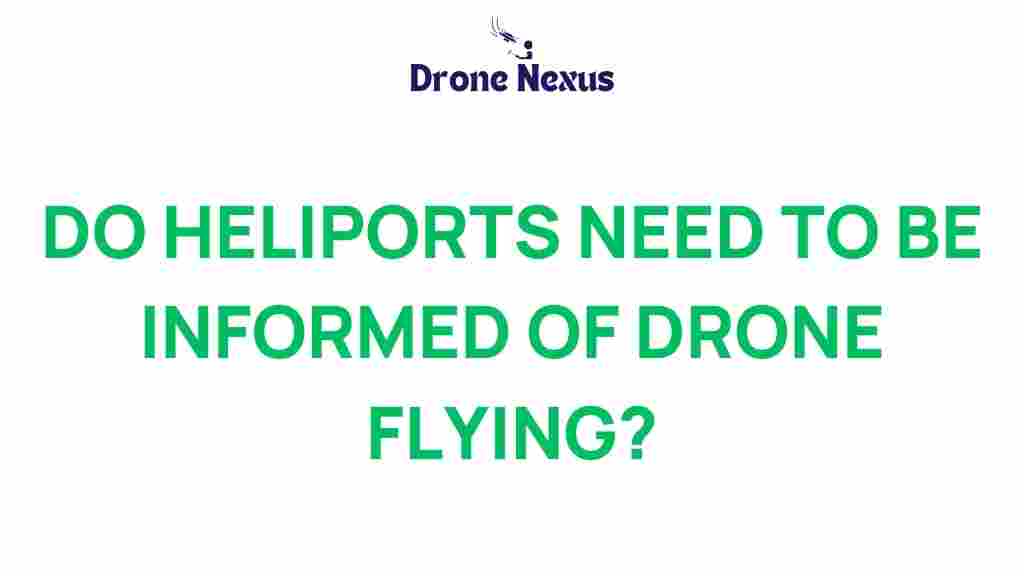Do Heliports Need to Be Informed of Drone Flights? Understanding the Impact of Drones
The rapid rise of drones in various sectors, from recreational use to commercial applications, has raised important questions about airspace management and safety. One significant issue in this growing landscape is whether heliports need to be informed of drone flights. As drone technology continues to evolve, understanding the dynamics between drone operations and heliport activities becomes crucial for maintaining safety and efficiency in the airspace.
The Current Landscape of Drone Usage
Drones, also known as unmanned aerial vehicles (UAVs), have transformed various industries, including photography, agriculture, delivery services, and infrastructure inspection. With their increasing prevalence, it’s essential to explore the regulatory frameworks and communication protocols that govern their operation, especially in proximity to heliports.
Understanding Heliport Operations
Heliports serve as critical hubs for helicopter operations, facilitating air ambulance services, news coverage, corporate travel, and more. The presence of drones in the airspace around these facilities can pose risks, making it vital to establish guidelines for communication between drone operators and heliport managers.
The Need for Communication: Why Heliports Should Be Informed of Drone Flights
As drone usage expands, the question arises: should heliports be notified of nearby drone flights? Here are several reasons why this communication is essential:
- Safety: Drones flying near heliports can interfere with helicopter operations, especially during takeoffs and landings. Informing heliports about drone flights can help mitigate potential accidents.
- Airspace Management: Effective communication allows for better airspace management, ensuring safe distances are maintained between drones and helicopters.
- Legal Compliance: Depending on local regulations, drone operators may be legally required to notify nearby heliports of their flights.
- Emergency Situations: In emergencies, such as medical evacuations, knowing the presence of drones can help coordinate air traffic more effectively.
Regulatory Aspects of Drone Operations
In many jurisdictions, drone operations are regulated by aviation authorities, which set rules for safe operation. These regulations often include:
- Altitude restrictions
- Prohibition of flights near airports and heliports
- Requirement for notifying air traffic control in certain situations
Understanding these regulations is crucial for drone operators to ensure compliance and safety. For more detailed information on drone regulations, you can visit the FAA’s official website.
Step-by-Step Process for Drone Operators
For drone operators, it’s essential to ensure that their flights do not interfere with heliport operations. Here’s a step-by-step process to follow:
Step 1: Understand Your Flight Area
Before planning a drone flight, familiarize yourself with the surrounding airspace and identify any nearby heliports. This knowledge will help you avoid potential conflicts.
Step 2: Check Local Regulations
Research local regulations regarding drone flights near heliports. Many countries have specific rules in place that govern how close a drone can fly to a heliport.
Step 3: Notify Heliport Management
If your drone flight is planned within a certain radius of a heliport, it’s prudent to notify the heliport management. Provide them with details like:
- Your drone’s registration number
- Flight time and duration
- Flight path and altitude
Step 4: Maintain Communication
Establish a line of communication with the heliport in case of any changes to your flight plan. This ensures that both parties are aware of each other’s operations.
Step 5: Monitor the Flight
During the flight, keep an eye on nearby helicopter activity. If a helicopter approaches, be prepared to alter your flight path or land the drone if necessary.
Troubleshooting Tips for Drone Operators
Even with the best planning, issues can arise during drone flights. Here are some troubleshooting tips to help you navigate common challenges:
1. Communication Failures
If you encounter difficulties communicating with heliport management:
- Double-check contact information and ensure you are using the correct channels.
- Try reaching out via multiple methods (phone, email, radio).
2. Sudden Weather Changes
Weather conditions can change rapidly, impacting your flight:
- Always check the weather forecast before your flight.
- Have a plan in place for safe landing if conditions worsen.
3. Technical Malfunctions
If your drone experiences a technical issue:
- Know the emergency protocols for your specific model.
- Have a backup plan for retrieving your drone safely.
4. Unexpected Helicopter Traffic
If a helicopter approaches your drone:
- Follow established protocols for yielding the right of way.
- Be prepared to land your drone immediately if instructed.
Conclusion: The Importance of Open Communication
The debate over whether heliports need to be informed of drone flights underscores the importance of safety in our increasingly crowded airspace. As the popularity of drones continues to rise, establishing clear communication between drone operators and heliport management is essential for minimizing risks and ensuring smooth operations.
By understanding the regulatory landscape, following best practices, and maintaining open lines of communication, drone operators can contribute to a safer environment for all air traffic. Whether you are a seasoned drone pilot or a newcomer, prioritizing safety and communication will benefit everyone involved in aerial activities.
For further reading and resources on drone safety, be sure to check out our comprehensive guide on UAV best practices.
This article is in the category Safety and created by DroneNexus Team
